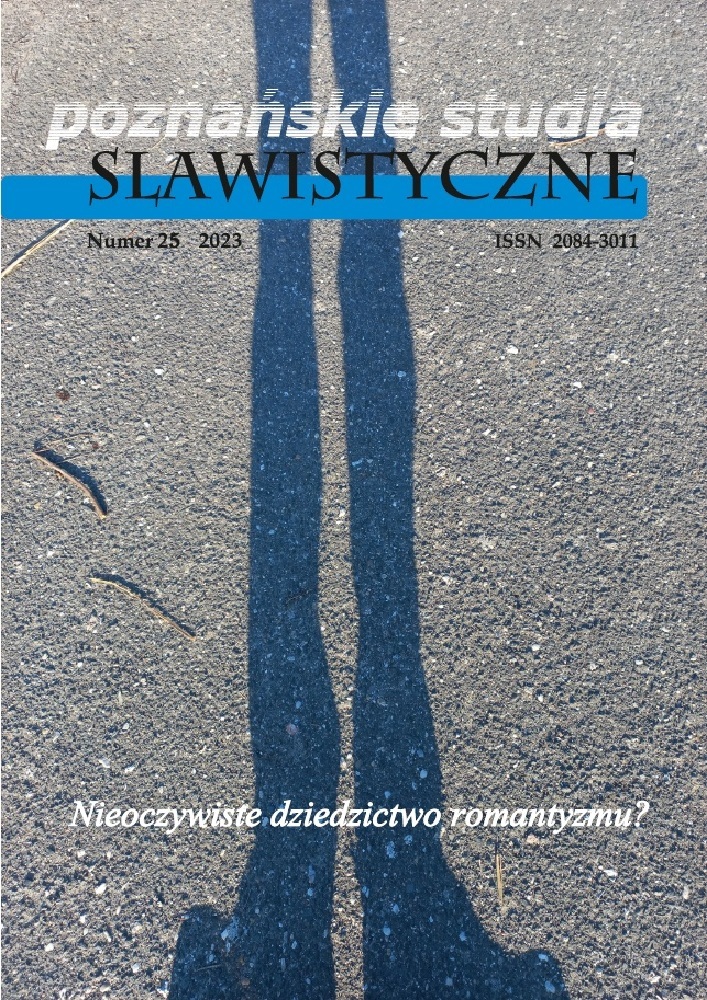Abstract
In the broadest sense, the paper is a discussion of Vesna Parun’s love poetry. The basic idea is that, on the one hand, it adheres to the romantic understanding of literature as a representation of the deepest personal feelings, universal truths, and essential values and, on the other hand, that it acts as a confirmation that the experience of love is fundamentally literary, and that literature is a form of unbridled love for linguistic seduction. For this reason, the author’s love poetry is not approached as a representation of her private life, love feelings, or relationships, but as a complex relationship between figurative language and a romanticized idea of love. In other words, it is interpreted as a discourse or rhetorical event that simultaneously constructs and deconstructs concepts such as authentic experience, sincere sensitivity, primordial love, or stable identity, and provides an opportunity to raise important ethical and political questions in the face of its ambivalence.
References
Badiou, A. (2014). What does the Poem Think?. In: The Age of the Poets. Ed. B. Bosteels. London–New York: Verso, pp. 23–35.
Bagić, K. (2012). Rječnik stilskih figura. Zagreb: Školska knjiga.
Barthes, R. (2001). A Lover’s Discourse. Fragments. New York: A division of Farrar, Straus and Giroux.
Bennett, A. (2005). The Author. London-New York: Routledge. Bennett, A and Royle, N. (2016). Love. In: An Introduction to Literature, Criticism and Theory. London-New York: Routledge, pp. 239–249.
Bilosnić, T. M. (1977). Skrovito srce bilja. Uz ljubavnu liriku Vesne Parun. “Republika,” no. 6 (33), pp. 601–618.
Biti, V. (2000). Pojmovnik suvremene književne i kulturne teorije. Zagreb: Matica hrvatska.
Clark, T. (1997). The Theory of Inspiration. Manchester-New York: Manchester University Press.
Culler, J. (1985). Changes in the Study of the Lyric. In: Lyric Poetry Beyond New Criticism. Eds. Chaviva Hošek and Patricia Parker. Ithaca-London: Cornell University Press, pp. 38–54.
Culler, J. (2001). Apostrophe. In: The Pursuit of Signs. London-New York: Routledge, pp. 149–171.
Culler, J. (2015). Theory of the Lyric. Cambridge-London: Harvard University Press. DOI: https://doi.org/10.4159/9780674425781
Čolak, T. (1963). Zlo i lepota ljubavi. “Književne novine,” no. 196 (15), p. 4.
De Man, P. (1981). Hypogram and Inscription: Michael Riffaterre’s Poetics of Reading. “Diacritics,” no. 4 (11), pp. 17–35. DOI: https://doi.org/10.2307/464972
De Man, P. (1984). Autobiography As De-Facement. In: The Rhetoric of Romanticism. New York: Columbia University Press, pp. 67–82.
Diana, S. (1955). Poezija tuge i ljubavi (‘Crna maslina’). “Mogućnosti,” no. 9 (2), pp. 703– 706.
Ferber, M. (2010). Romanticism. New York: Oxford University Press. DOI: https://doi.org/10.1093/actrade/9780199568918.001.0001
Hollinshead-Strick, C. (2017). The Emancipated Spectator and Modernism. In: Understanding Rancière, Understanding Modernism. Ed. Patrick M. Bray. New York: Bloomsbury, pp. 83–95.
Holmes, O. (2000). Assembling the Lyric Self. Minneapolis-London: University of Minnesota Press.
Jay, P. (1984). Being in the Text. Self-Representation from Wordsworth to Roland Barthes. Ithaca-London: Cornell University Press.
Kay, S. (1990). Subjectivity in Troubadour Poetry. Cambridge-New York: Cambridge University Press. DOI: https://doi.org/10.1017/CBO9780511519550
Knežević, S. (2022). Golubica iz crnoga maslinika. Studije o književnom djelu Vesne Parun. Zagreb: Hrvatska sveučilišna naklada-Sveučilište u Zadru.
Kugel, J. L. (1990). Poetry and Prophecy. Ed. James L.Kugel. Ithaca-London: Cornell University Press.
Lacan, J. (1986). Četiri temeljna pojma psihoanalize. Zagreb: Naprijed.
Lacan, J. (2005). Encore. Paris: Éditions du Seuil.
Lemac, T. (2015). Autorsko, povijesno, mitsko. (Pjesnički diskurs Vesne Parun – teorija i interpretacija). Zagreb: Biakova.
Martin, C. (1994). Policy in Love: Lyric and Public in Ovid, Petrarch, and Shakespeare. Pittsburgh: Duquesne University Press.
Milačić, K. (1995). Pjesničko djelo Vesne Parun. In: Izbor iz djela. Zagreb: Školska knjiga, pp. 5–22.
Milićević, N. (1982). [Predgovor]. In: Vesna Parun. Izabrana djela. Ed. N. Milićević. Zagreb: Nakladni zavod Matice hrvatske, pp. 7–34.
Oblučar, B. (2023). Rasijana žudnja – figure ljubavnog diskursa u poeziji Vesne Parun. [Work in manuscript.]
Paglia, C. (1993). Love Poetry. In: The New Princeton Encyclopedia of Poetry and Poetics. Eds. A. Preminger and T.F. Brogan. Princeton: Princeton University Press, pp. 705–713.
Pavletić, V. (1983). Pjesma je sat koji otkucava riječi. [Interview with Vesna Parun.] “Forum,” no. 7–9 (23), pp. 454–491.
Parun, V. (1955). Crna maslina. Zagreb: Naklada društva književnika Hrvatske. Parun, V. (1959). Ti i nikad. Zagreb: Lykos.
Parun, V. (1963). Jao jutro. Beograd: Prosveta. Parun, V. (1969). Ukleti dažd. Zagreb: personal print.
Parun, V. (1990). Pjesma je unutrašnje ilegalno ogledalo. In: Nedovršeni mozaik. Ed. Karmen Milačić. Zagreb: Mladost, pp. 65–70.
Parun, V. (2010). Ja koja imam nevinije ruke. Zagreb-Sarajevo: Naklada ZORO–Profil Multimedija.
Rancière, J. (2014). Le Fil perdu: Essais sur la fiction moderne Paris: La Fabrique. Slamnig, I. (1981). Hrvatska versifikacija. Zagreb: Liber.
Šoljan, A. (1978). Tragična ćutilnost Vesne Parun. “Delo,” no. 12 (24), pp. 77–87.
Tomičić, Z. (1959). Pjesnički svijet Vesne Parun [Predgovor]. In: V. Parun, Ti i nikad. Zagreb: Lykos, pp.IX–LIV.
Vereš, S. (1972). Probuđeni Endimion. “Izraz,” no. 10 (16), pp. 259–270.
Vuković, T. (2018). Na kraju pjesme. Zagreb: Meandarmedia.
License
Copyright (c) 2023 Tvrtko Vuković

This work is licensed under a Creative Commons Attribution 4.0 International License.

